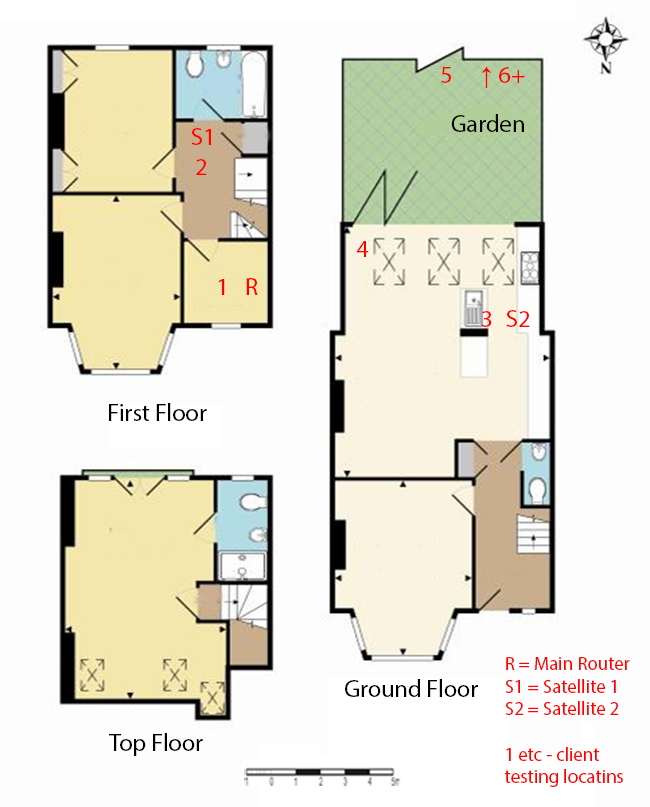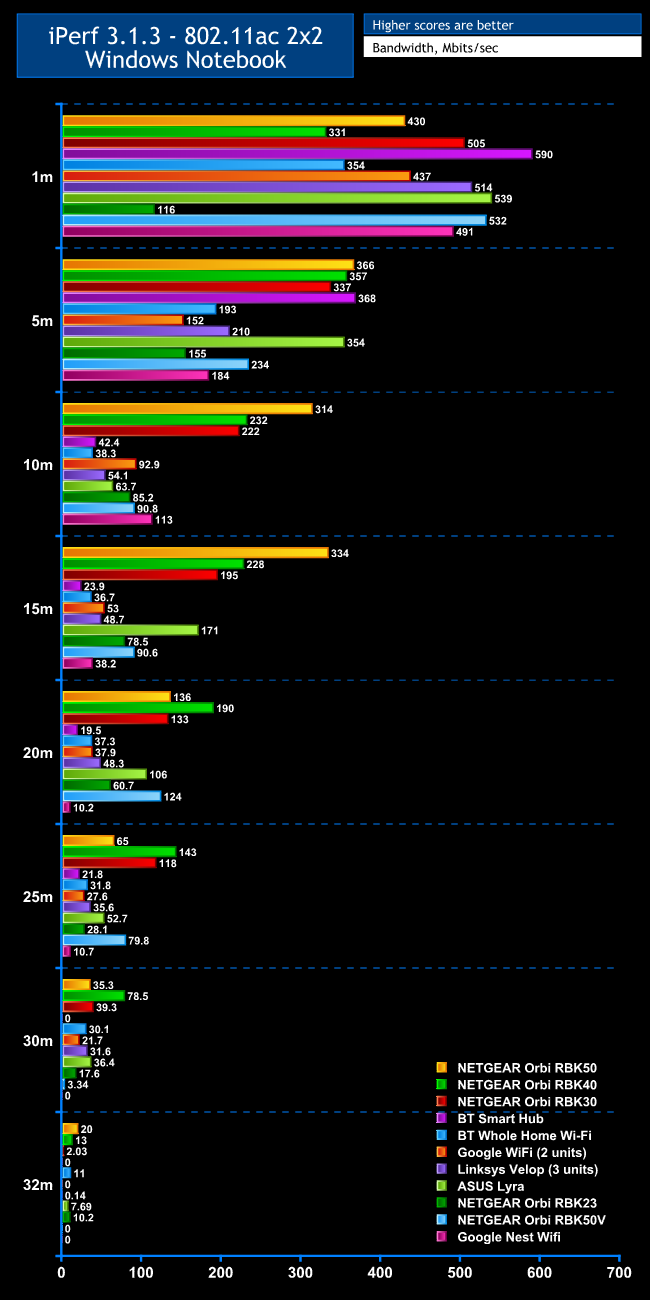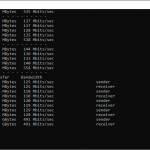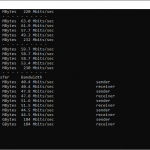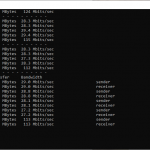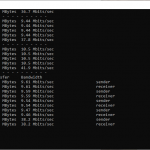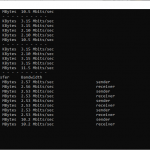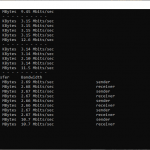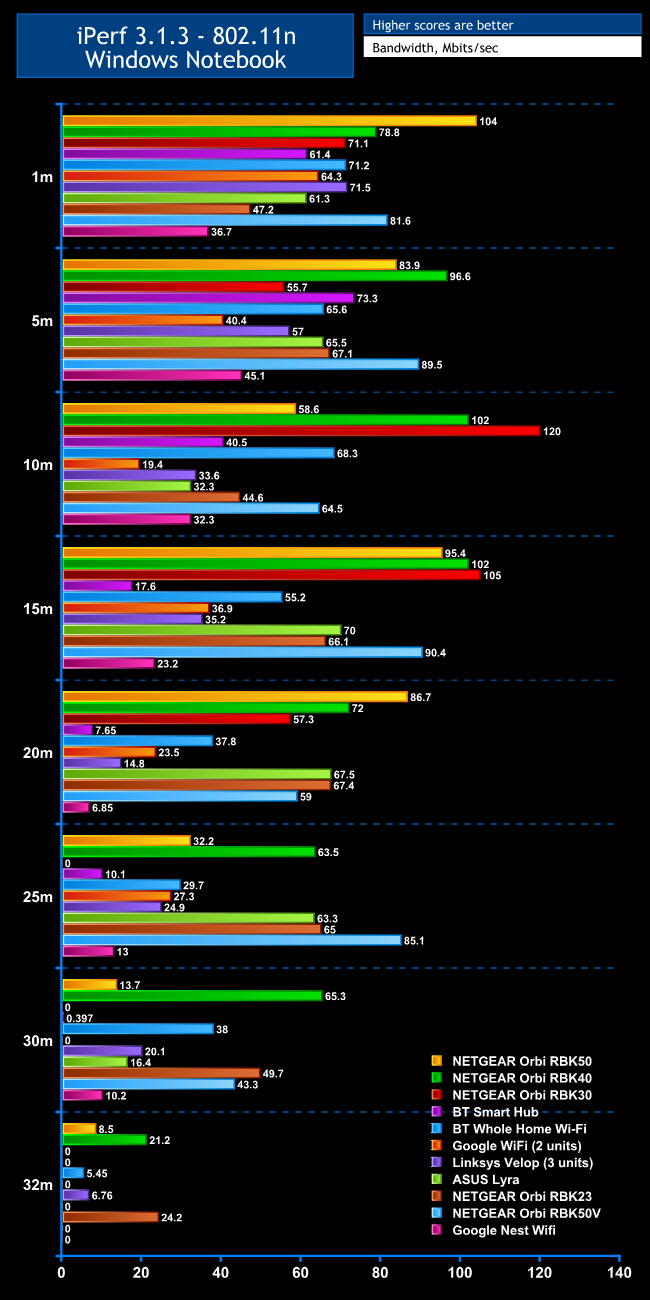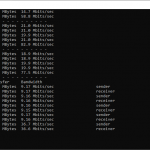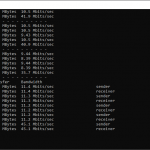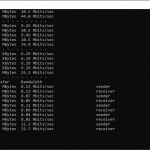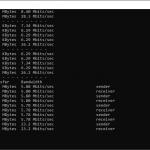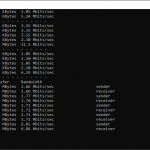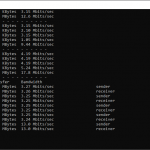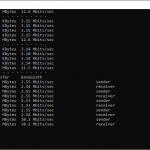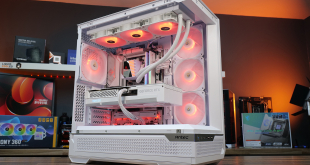We replicated the testing from our Ultimate Mesh WiFi Router Shootout as closely as possible with the Google Nest Wifi. However, we no longer had the Apple Macbook Pro in our possession, so had to leave this set of tests out.
We repeated the positions from the Ultimate Mesh WiFi Router Shootout, with eight different locations for our test notebooks. The clients used were an HP Spectre 13 X2 notebook with 2×2 802.11ac WiFi, and an older HP Folio 13, which maxes out at 3×3 802.11n WiFi.
In each case, we used the freely available iPerf 3.1.3 software, which stresses a network by sending packets of random data and measures the throughput. One system acts as a server, and the other as a client, as data is sent between them. In all cases, we used an Armari Windows 10 workstation connected to the primary router unit via Gigabit Ethernet as the server, so that the WiFi was always the slowest connection.
These are the iPerf commands we used:
For the server: iperf3 –s –i 1
For the client: iperf3 –c <IP Address> –P 4 –i 1 –t 60
Note that the client command sends four streams of data simultaneously, simulating a multi-client connection as closely as possible with just one client. It takes 60 throughput readings at one second intervals and then averages the result.
The above diagram shows the layout of the house we used for testing. Note that we didn't test on the top floor of the house because this was directly above the first floor and wouldn't have provided much of a range test. Instead, we used two locations on the same floor as the router (the first floor), then more distant locations on the ground floor extending out the back of the house into the garden.
Each test location, numbered in the diagram above, was approximately 5m away from the last one.
With the mesh networking and standalone router products used for comparison, location 1 was very near to the router, around 1m away. The next location – 2 – was around 5m away, with a wall in the way, but on the same floor. Location 3 was on the floor below, so had walls and a floor in between, but was a further 5m away. Location 4 was the last one actually inside the house. Locations 5 to 7 were then 5m further down the garden. Location 8 was only 2m further down, as this was the end of the garden, but also behind a shed, so posed a significant challenge that only a few mesh WiFi systems can cope with.
We should also say a few words about the location of the satellites. The routers or primary unit were always placed in the same location, in the first-floor study next to the broadband. In the case of three-unit mesh systems such as BT Whole Home Wi-Fi and the top Velop option, the second and third satellites were placed at S1 and S2.
With the two-unit Google WiFi, the second unit was placed at S1, due to the recommendation of the setup software. However, in the case of the Orbi RBK50, it was possible to place the second unit at S2, due to the signal strength from these systems.
For the Google Nest Wifi system, we placed the primary unit in location R, with the satellite speaker at S1, again according to the software's recommendation.
802.11ac 5GHz
Within 1m, the Google Nest Wifi puts up a decent performance, achieving 491Mbits/sec, just behind the NETGEAR Orbi RBK30, although the standalone BT Smart Hub still reigns supreme at close proximity.
At 5m, the Google Nest Wifi drops like a stone, however. Although 184Mbits/sec is still a decent performance, and better than the original Google Wifi could manage at this range, it's way behind a lot of other mesh systems.
Moving further to 10m, however, and the Google Nest Wifi is a lot more competitive again, managing 113Mbits/sec, which only NETGEAR's Orbi RBK30, 40 and 50 can beat.
Unfortunately, the Google Nest Wifi can't maintain this out to 15m, achieving a merely usable 38.2Mbits/sec. The decline continues to 20m, hitting a barely usable 10.2Mbits/sec, although this is maintained to 25m, with 10.7Mbits/sec. Beyond that, however, the Google Nest Wifi can't even get a signal.
It's worth noting the original Google Wifi did manage to reach 30m, and had better performance at 15m and beyond. So for 802.11ac the Google Nest Wifi is a step back in range. We'd really only recommend using it in a home that requires a WiFi range of less than 15m, and optimally 10m, although it's perfectly adequate within this area.
802.11n 2.4GHz
Unfortunately, the Google Nest Wifi does not offer particularly stunning performance with 2.4GHz 802.11n. At a close range of 1m, it's the slowest mesh system we've tested, only managing 36.7Mbits, although this does improve a bit at 5m to 45.1Mbits/sec.
However, the picture is a bit more positive at longer ranges, with 32.3Mbits/sec at 10m, although 23.2Mbits/sec at 15m is barely better than a standalone BT Smart Hub.
Strangely, although throughput drops to an almost unusable 6.85Mbits/sec at 20m, this rises to 13Mbits/sec at 25m, and you're still getting 10.2Mbits/sec at 30m, although this doesn't extend to 32m. The shed in the way blocked the WiFi completely.
Overall, you're getting a reasonable range, and much better than the original Google Wifi, but performance within that range isn't particularly impressive.
 KitGuru KitGuru.net – Tech News | Hardware News | Hardware Reviews | IOS | Mobile | Gaming | Graphics Cards
KitGuru KitGuru.net – Tech News | Hardware News | Hardware Reviews | IOS | Mobile | Gaming | Graphics Cards


